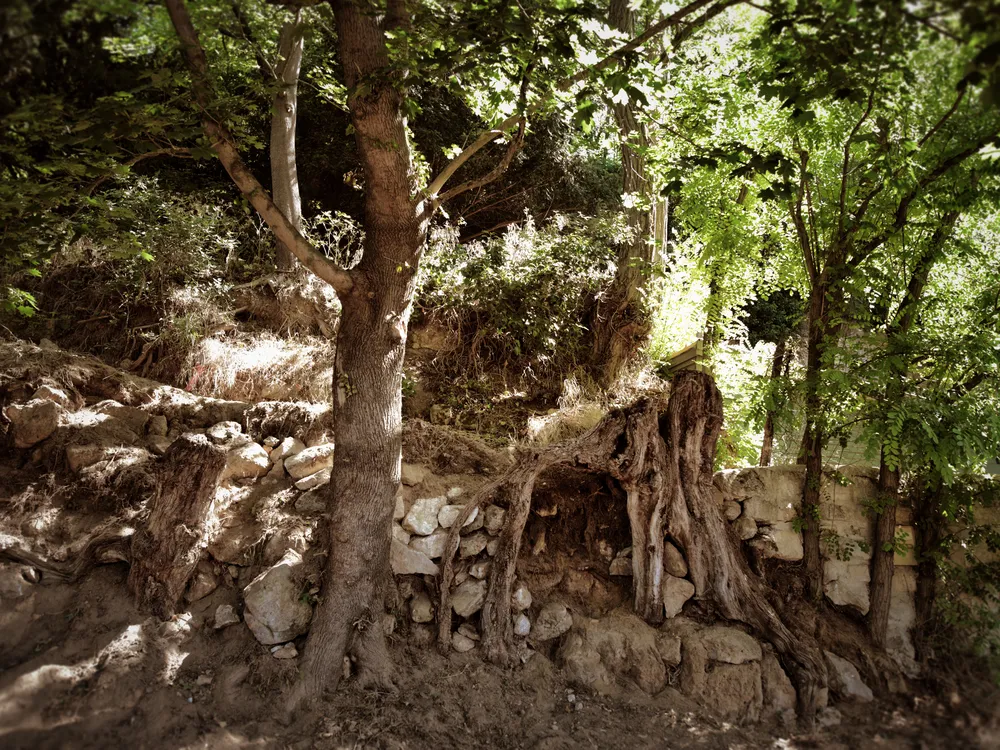Who Should Own the Hillside Where Vincent van Gogh Made His Last Painting?
Who Should Own the Hillside Where Vincent van Gogh Made His Last Painting?
The real-life location of the Dutch Post-Impressionist’s 1890 painting “Tree Roots” has been the subject of five years of legal battles between homeowners and a French mayor who wants to turn the site public
The roots along Rue Daubigny in Auvers-sur-Oise as they appeared in 2020
Arthénon / Van Gogh Museum
On a late July morning in 1890, Vincent van Gogh rose from his lodgings in the small French countryside town of Auvers-sur-Oise and set out to paint. He didn’t have far to walk through the village before he arrived at his subject: a tangle of roots on the side of Rue Daubigny.
Tree Roots, the painting he made that day, was his last. Later that evening, van Gogh staggered back to his room at the inn with a self-inflicted gunshot wound to his chest. He died in bed two days later.
More than 130 years after van Gogh painted Tree Roots, the painting is still stirring controversy in Auvers-sur-Oise, a usually serene town of less than 7,000 people, around 17 miles from the center of Paris.
Since researchers identified the exact location of the roots in 2020, the couple that owns 48 Rue Daubigny have been embroiled in a five-year legal struggle with the mayor of Auvers-sur-Oise, who wants to turn the site public.
The debate centers around whether the roots are part of the garden of Jean-François and Hélène Serlinger or a part of the town-owned Rue Daubigny. A 2023 ruling determined that the roots were indeed private property. After an appeal by Mayor Isabelle Mézières, another court affirmed the previous ruling last month.
Tree Roots, van Gogh's final painting
Van Gogh Museum (Vincent van Gogh Foundation)
“The embankment containing the tree roots painted by Vincent van Gogh does not constitute an accessory to the public highway,” an appeals court based in Versailles ruled on March 18, per Euronews’ Theo Farrant.
The Serlingers, who moved to the town in 1996 and bought the land in 2013—seven years before the roots were identified—expressed relief about the court’s seemingly final ruling.
“We are very happy that this is now over,” Hélène Serlinger, an artist, tells the Independent’s Athena Stavrou. “The mayor tried to grab the bottom part of the [site] by saying it was part of the road, which is terrible.”
Since 2020, the couple has operated vangoghroots.com and hosted guided tours of the site for $9, adding it to the network of van Gogh-related sites that pepper Auvers-sur-Oise, including the room where he died, the wheat field where he painted Wheatfield with Crows and his grave on the outskirts of town.
The postcard where the location of Tree Roots was recognized
Arthénon / Van Gogh Museum
“We’re going to devote our energy now to protecting the site,” Jean-François Serlinger, a retired tax inspector, tells the Times of London’s Charles Bremner. “This story is behind us.”
For the mayor, however, the story is far from over. She denounced the court’s decision in a statement posted to Facebook on April 1 and suggested that the town would appeal the ruling even further. “The question of ownership is not settled,” Mézières wrote. “These roots are a common good, not a commercial object.”
But for 130 years, the location of the infamous roots was a mystery. Van Gogh’s abstract, swirling painting offered no definitive clues. The roots belonged to no one.
It wasn’t until Wouter van der Veen, the scientific director of the Institut van Gogh in Auvers-sur-Oise, discovered a 1900s postcard depicting the hillside along Rue Daubigny that the location of the painting finally became clear.
Tree Roots overlaid on the historic postcard
Arthénon / Van Gogh Museum
“Every element of this mysterious painting can be explained by observation of the postcard and the location: the shape of the hillside, the roots, their relation to each other, the composition of the earth and the presence of a steep limestone face,” van der Veen explained in a statement from the Van Gogh Museum in 2020.
After a historical photograph showed a different angle of the same site and a dendrologist examined the modern hillside, the location of van Gogh’s last painting was confirmed.
“Ending his life with this painting makes so much sense,” van der Veen told the New York Times’ Nina Siegal in 2020. “The painting illustrates the struggle of life, and a struggle with death. That’s what he leaves behind. It is a farewell note in colors.”
Get the latest stories in your inbox every weekday.


